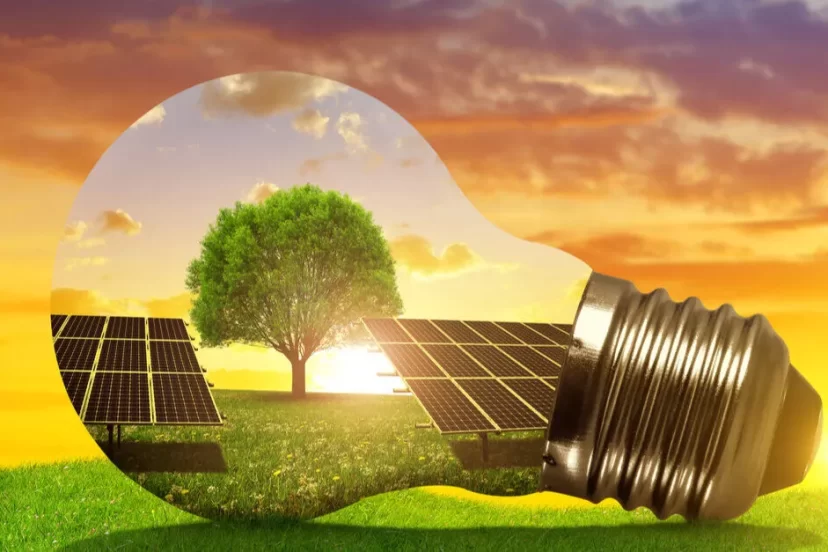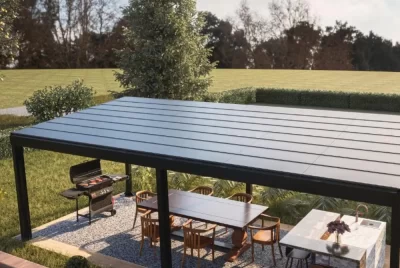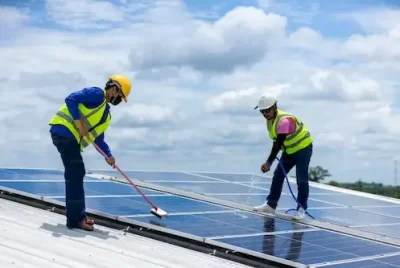How Does Solar Panels Work? A Step-by-Step Explanation of Photovoltaic Systems
We may earn a commission for purchases made using our links. See our disclosure to learn more.
Solar panels have gained immense popularity in recent years as a clean and renewable energy source. They offer a sustainable alternative to traditional power generation methods and can significantly reduce reliance on fossil fuels. In this article, I will provide a comprehensive guide to understanding how solar panels work, taking you through the step-by-step process of photovoltaic systems.
Introduction
Solar panels, also known as photovoltaic panels, harness the power of the sun to generate electricity. They consist of multiple solar cells made of semiconductor materials, usually silicon, that convert sunlight directly into electricity through a phenomenon called the photovoltaic effect.
What are solar panels?
Solar panels are devices that capture sunlight and convert it into usable electrical energy. The basic building block of a solar panel is the solar cell, which is responsible for the conversion process. Solar cells are made of semiconducting materials, such as silicon, that have the ability to convert sunlight into electricity.
Photovoltaic systems: How they work
Photovoltaic systems, commonly referred to as PV systems, are the combination of multiple solar panels connected together to generate electricity. These systems utilize the photovoltaic effect to convert sunlight into electrical energy. When sunlight strikes the solar cells, it excites the electrons, creating an electric current.
Components of a photovoltaic system
A typical photovoltaic system consists of several components that work together to generate electricity.
Solar panels
These are made up of multiple solar cells and are responsible for capturing sunlight and converting it into electricity.
Inverter
The inverter converts the direct current (DC) electricity produced by the solar panels into alternating current (AC) electricity, which is compatible with standard electrical devices used in homes and businesses.
Batteries (if applicable)
In some cases, photovoltaic systems may include battery storage to store excess electricity generated during the day for use during nighttime or periods of low sunlight.
A step-by-step explanation of how solar panels work
1. Step 1: Absorption of sunlight When sunlight strikes the solar panels, the semiconducting material (usually silicon) absorbs the photons,
creating an energy boost to the electrons within the material.
2. Step 2: Creation of an electric field The absorbed energy causes the electrons to become loose and move freely within the material, creating an electric field.
3. Step 3: Generation of electricity As the loose electrons move, they create a flow of electricity. This flow is captured by the conductive metal contacts on the solar cell, generating a direct current (DC) electrical output.
4. Step 4: Conversion of DC to AC (if applicable) In order to power standard electrical devices used in homes and businesses, the DC electricity produced by the solar panels needs to be converted into alternating current (AC) electricity. This is where the inverter comes into play. The inverter transforms the DC electricity into AC electricity, making it compatible with the existing electrical grid.
5. Step 5: Powering electrical devices The AC electricity generated by the photovoltaic system can now be used to power various electrical devices and appliances, providing a sustainable and renewable source of energy.
Advantages of solar panels
Solar panels offer numerous advantages that make them an attractive choice for homeowners and businesses alike.
Environmental benefits
Solar panels produce clean energy without emitting harmful greenhouse gases or pollutants. By using solar power, we can significantly reduce our carbon footprint and contribute to a greener and more sustainable future.
Cost savings
Although the initial cost of installing solar panels can be significant, they provide long-term cost savings. Solar energy is free, and by generating your own electricity, you can reduce or eliminate your monthly utility bills.
Energy independence
Solar panels offer a degree of energy independence. By generating your own electricity, you are less reliant on traditional power sources and are better prepared for power outages or disruptions in the electrical grid.
Considerations before installing solar panels
Before investing in solar panels, there are several important considerations to keep in mind.
1. Location and sunlight availability: The amount of sunlight your location receives is a crucial factor in the efficiency of solar panels. Ensure that your property has sufficient access to sunlight throughout the day to maximize the energy production.
2. Roof suitability: Evaluate the suitability of your roof for installing solar panels. Factors such as roof orientation, tilt, shading, and structural integrity should be assessed to determine the feasibility of installation.
3. Financial considerations: Consider the upfront cost of installing solar panels and evaluate the potential return on investment. Additionally, explore any available financial incentives, such as tax credits or rebates, that can help offset the initial expenses.
Common misconceptions about solar panels
There are several misconceptions surrounding solar panels that need to be addressed.
1. Myth 1: Solar panels only work in sunny climates. While it’s true that solar panels perform optimally in regions with abundant sunlight, they can still generate electricity in cloudy or overcast conditions. Solar panels can utilize diffused sunlight, although their efficiency may be slightly reduced.
2. Myth 2: Solar panels require constant maintenance. Solar panels are designed to be low-maintenance. While periodic cleaning may be necessary to remove dirt or debris, they generally require minimal attention once installed.
3. Myth 3: Solar panels are too expensive. While the initial cost of installing solar panels can be significant, the long-term savings on energy bills and potential financial incentives can make them a cost-effective choice in the long run.
Tips for maximizing solar panel efficiency
To ensure optimal performance and efficiency of your solar panels, consider the following tips:
1. Regular cleaning and maintenance: Keep your solar panels clean and free from dirt, dust, or debris that may hinder their performance. Regularly inspect and clean them to ensure maximum sunlight absorption.
2. Proper positioning and angling of solar panels: Position your solar panels in a location that receives the maximum amount of sunlight throughout the day. Additionally, adjust the tilt and angle of the panels to optimize their exposure to the sun’s rays.
3. Using energy-efficient appliances: Pairing your solar panel system with energy-efficient appliances and devices can further enhance your energy savings. Energy-efficient appliances consume less electricity, allowing you to maximize the utilization of your solar-generated power.
Conclusion
Solar panels, through the utilization of photovoltaic systems, offer a sustainable and environmentally friendly way to generate electricity. By understanding the step-by-step process of how solar panels work, as well as the benefits and considerations associated with their installation, individuals can make informed decisions about incorporating solar energy into their lives. Embracing solar power not only contributes to a greener future but also provides cost savings and energy independence.
FAQs (Frequently Asked Questions)
1. Are solar panels completely maintenance-free?
While solar panels are designed to be low-maintenance, regular cleaning to remove dirt or debris is recommended to ensure optimal performance.
2. Do solar panels work during power outages?
Solar panels alone will not provide power during a power outage, as they are grid-tied. However, with the addition of battery storage, you can have backup power during outages.
3. How long do solar panels last?
Solar panels are built to be durable and typically come with a warranty of 25 to 30 years. However, their actual lifespan can exceed 30 years with proper maintenance.
4. Can I install solar panels on any type of roof?
Solar panels can be installed on various roof types, including asphalt shingles, metal roofs, and flat roofs. The suitability may vary based on structural integrity and orientation.
5. What happens if my solar panels produce more electricity than I consume?
Excess electricity produced by your solar panels can be fed back into the grid, allowing you to earn credits or receive compensation from your utility company through net metering programs.
6. Can I install solar panels myself, or do I need professional installation?
While it is possible to install solar panels yourself, it is recommended to seek professional installation. They have the expertise and knowledge to ensure proper installation, wiring, and compliance with local regulations.
7. Do solar panels work in cold climates?
Yes, solar panels can still generate electricity in cold climates. In fact, they can be more efficient in colder temperatures as excessive heat can reduce their performance.
8. Will installing solar panels increase the value of my home?
Yes, installing solar panels can increase the value of your home. Studies have shown that homes equipped with solar panels tend to sell at higher prices and have faster selling times compared to homes without solar.
9. Can I finance the installation of solar panels?
Yes, there are various financing options available for solar panel installations, such as loans, leases, and power purchase agreements. These options make solar panel installations more accessible and affordable.
10. What happens on cloudy days or during nighttime when solar panels can’t produce electricity?
During cloudy days or nighttime, when solar panels cannot produce electricity, you can still rely on the electrical grid for power. However, if you have a battery storage system, you can utilize the stored energy to power your home during those periods.
By following these guidelines and understanding the workings of solar panels and photovoltaic systems, you can make informed decisions about incorporating solar energy into your life. Embrace the clean and renewable power of the sun, and contribute to a more sustainable and energy-efficient future.




